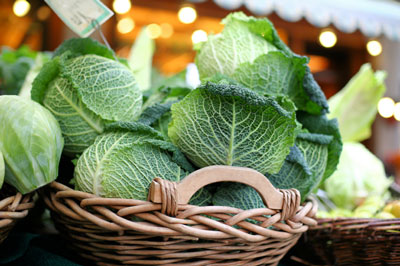Eating Healthy with Cruciferous Vegetables
Numerous individuals are acquainted with the expression "cruciferous vegetables" and can even recognize a vegetable like broccoli as having a place with this aggregation. But since examination on cruciferous vegetables has soar in the course of the last three to seven years, numerous individuals are not acquainted with the most recent science on this age-old assembly of vegetables.
The name "cruciferous vegetables" is itself experiencing change! This gathering of vegetables was initially named for the four equivalent estimated petals in its blossoms that could be seen as shaping a cross-like or cross shape. Be that as it may numerous researchers are beginning to support the expression "brassica vegetables" over "cruciferous vegetables" and the universal name of this plant family in Latin, Cruciferae, is currently being to a great extent traded by the Latin name Brassicaceae. (In Latin, the saying "brassica" essentially interprets as "cabbage," and cabbage is most likely an offered part of this vegetable assembly.)
You'll additionally hear agriculturists alluding to nourishments in this vegetable assembly as "cole yields." The statement "cole" (which is not difficult to spot in the saying "coleslaw," a dish normally a product of cabbage additionally from cruciferous vegetables like broccoli) by and by takes us once more to the Latin dialect; it originates from the expression "caulis" that alludes to the stalks of plants, particularly to the stalk of the cabbage plant. (Interestingly, you can discover this Latin establish not in the cabbages that so generally speak to the more extensive group of cruciferous vegetables, however in cauliflower, which is an alternate critical part of this vegetable aggregation.) Cruciferous vegetables are likewise at times alluded to as the mustard family vegetables, since the broadly famous mustard greens — and mustard seeds and mustard oils — additionally fit in with this vegetable assembly.
The table beneath holds an exhaustive rundown of cruciferous vegetables that are generally devoured as a piece of foods around the world:
Two particularly basic investigative groupings of cruciferous vegetables are the Brassica oleracea (broccoli, Brussels sprouts, cabbage, cauliflower, collards, kale, and kohlrabi) and the Brassica rapa (Chinese cabbage and turnips). Brassica campestris is an alternate name for the family species gathering called Brassica rapa.
Expected Nutrients in Cruciferous Vegetables
The name "cruciferous vegetables" is itself experiencing change! This gathering of vegetables was initially named for the four equivalent estimated petals in its blossoms that could be seen as shaping a cross-like or cross shape. Be that as it may numerous researchers are beginning to support the expression "brassica vegetables" over "cruciferous vegetables" and the universal name of this plant family in Latin, Cruciferae, is currently being to a great extent traded by the Latin name Brassicaceae. (In Latin, the saying "brassica" essentially interprets as "cabbage," and cabbage is most likely an offered part of this vegetable assembly.)
You'll additionally hear agriculturists alluding to nourishments in this vegetable assembly as "cole yields." The statement "cole" (which is not difficult to spot in the saying "coleslaw," a dish normally a product of cabbage additionally from cruciferous vegetables like broccoli) by and by takes us once more to the Latin dialect; it originates from the expression "caulis" that alludes to the stalks of plants, particularly to the stalk of the cabbage plant. (Interestingly, you can discover this Latin establish not in the cabbages that so generally speak to the more extensive group of cruciferous vegetables, however in cauliflower, which is an alternate critical part of this vegetable aggregation.) Cruciferous vegetables are likewise at times alluded to as the mustard family vegetables, since the broadly famous mustard greens — and mustard seeds and mustard oils — additionally fit in with this vegetable assembly.
The table beneath holds an exhaustive rundown of cruciferous vegetables that are generally devoured as a piece of foods around the world:
Cruciferous Vegetables
- Arugula
- Bok choy
- Broccoli
- Brussels sprouts
- Cabbage
- Cauliflower
- Chinese cabbage
- Collard greens
- Daikon radish
- Horseradish
- Kale
- Kohlrabi
- Land cress
- Mustard greens
- Radish
- Rutabaga
- Shepherd's purse
- Turnip
- Watercress
Two particularly basic investigative groupings of cruciferous vegetables are the Brassica oleracea (broccoli, Brussels sprouts, cabbage, cauliflower, collards, kale, and kohlrabi) and the Brassica rapa (Chinese cabbage and turnips). Brassica campestris is an alternate name for the family species gathering called Brassica rapa.
Expected Nutrients in Cruciferous Vegetables
As far as routine supplements (vitamins, minerals, proteins, carbs, and fats), we can't discover an alternate vegetable gathering that is as high in vitamin A carotenoids, vitamin C, folic corrosive, and fiber as the cruciferous vegetables. As an assembly, the cruciferous vegetables are essentially superstars in these ordinary supplement regions.
The vitamin K substance of cruciferous vegetables — particularly kale and collards — is entrancing to ponder in light of serious research in the course of recent years on tumor, irritation, and cruciferous vegetables. Vitamin K is an ordinary supplement that plainly aides direct our provocative reaction, including constant, exorbitant incendiary reactions that can build our danger of specific tumors. Thinks about on cruciferous vegetables and malignancy avoidance have not regularly concentrated on vitamin K fundamentally, yet we think that the stunning K substance of cruciferous vegetables is certainly identified with their disease preventive properties through components including better control of aggravation.
The astounding amassing of vitamin A carotenoids in cruciferous vegetables and their curiously high substance of vitamin C and manganese are plainly enter segments in their developing notoriety as a cell reinforcement vegetable gathering. Investigative enthusiasm toward the cancer prevention agent capacity of the cruciferous vegetables has been sufficient to trigger financing of isotope studies on cruciferous vegetables that archive the uptake of cell reinforcements in these sustenances from our digestive tract into our circulation system. We've seen concentrates on 13c-marked kale that show amazing bioavailability of beta-carotene, lutein, and retinol from this cruciferous vegetable. Noteworthy expands in the blood levels of these key cancer prevention agent supplements have been seen rapidly in subjects who devour liberal measures of cruciferous vegetables in exploration studies. ("Liberal" in one such think about implied utilization of 3 mugs of whitened, hacked broccoli throughout a dinner.) The cancer prevention agent lavishness of cruciferous vegetables has likewise been expressly specified in a few late studies as one of the solid givers to the danger bringing down effect of cruciferous vegetables on various types of disease.
One hundred calories' worth of cruciferous vegetables (about 5-6% of a day by day eating regimen) gives something like 25-40% of your day by day fiber necessity! That truth shows what an unbelievable deal cruciferous vegetable are regarding the matter of fiber. We associate that its unified with the reasons these vegetables have gotten to be progressively unmistakable in exploration contemplates on eating methodology and digestive backing. We may not regularly contemplate cruciferous vegetables when recognizing digestive issue or danger of digestive tract malignancies, yet we ought to.
Two extra macronutrients — proteins and fats — likewise merit exceptional notice as for late research on cruciferous vegetables. We have a tendency to contemplate vegetables, nuts, seeds, meats, dairy, and fish as the eating methodology's superior protein sources — as they may be. At the same time cruciferous vegetables can help a shocking measure of protein to the eating regimen — in excess of 25% of the Daily Value in 3 glasses — and at a low calorie cost. Two hundred calories of steamed broccoli will furnish you with 20 grams of protein — not to the extent that the 30 grams in two hundred calories of cooked chicken bosom
The vitamin K substance of cruciferous vegetables — particularly kale and collards — is entrancing to ponder in light of serious research in the course of recent years on tumor, irritation, and cruciferous vegetables. Vitamin K is an ordinary supplement that plainly aides direct our provocative reaction, including constant, exorbitant incendiary reactions that can build our danger of specific tumors. Thinks about on cruciferous vegetables and malignancy avoidance have not regularly concentrated on vitamin K fundamentally, yet we think that the stunning K substance of cruciferous vegetables is certainly identified with their disease preventive properties through components including better control of aggravation.
The astounding amassing of vitamin A carotenoids in cruciferous vegetables and their curiously high substance of vitamin C and manganese are plainly enter segments in their developing notoriety as a cell reinforcement vegetable gathering. Investigative enthusiasm toward the cancer prevention agent capacity of the cruciferous vegetables has been sufficient to trigger financing of isotope studies on cruciferous vegetables that archive the uptake of cell reinforcements in these sustenances from our digestive tract into our circulation system. We've seen concentrates on 13c-marked kale that show amazing bioavailability of beta-carotene, lutein, and retinol from this cruciferous vegetable. Noteworthy expands in the blood levels of these key cancer prevention agent supplements have been seen rapidly in subjects who devour liberal measures of cruciferous vegetables in exploration studies. ("Liberal" in one such think about implied utilization of 3 mugs of whitened, hacked broccoli throughout a dinner.) The cancer prevention agent lavishness of cruciferous vegetables has likewise been expressly specified in a few late studies as one of the solid givers to the danger bringing down effect of cruciferous vegetables on various types of disease.
One hundred calories' worth of cruciferous vegetables (about 5-6% of a day by day eating regimen) gives something like 25-40% of your day by day fiber necessity! That truth shows what an unbelievable deal cruciferous vegetable are regarding the matter of fiber. We associate that its unified with the reasons these vegetables have gotten to be progressively unmistakable in exploration contemplates on eating methodology and digestive backing. We may not regularly contemplate cruciferous vegetables when recognizing digestive issue or danger of digestive tract malignancies, yet we ought to.
Two extra macronutrients — proteins and fats — likewise merit exceptional notice as for late research on cruciferous vegetables. We have a tendency to contemplate vegetables, nuts, seeds, meats, dairy, and fish as the eating methodology's superior protein sources — as they may be. At the same time cruciferous vegetables can help a shocking measure of protein to the eating regimen — in excess of 25% of the Daily Value in 3 glasses — and at a low calorie cost. Two hundred calories of steamed broccoli will furnish you with 20 grams of protein — not to the extent that the 30 grams in two hundred calories of cooked chicken bosom



Comments
Post a Comment